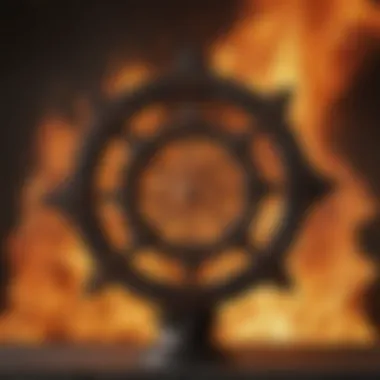The Divine Embers: Fire Gods in World Mythologies


Intro
Fire has always been a powerful element, central to life and destruction alike. Across cultures, the god of fire is often depicted as a transformative force, embodying both creation and chaos. From the underworld to the heavens, these divine beings sculpt stories around flames that have inspired worship, fear, and respect throughout time. This exploration seeks to delve into the diverse representations of fire gods across mythologies, capturing their attributes, narratives, and the integral roles they play in shaping human experience.
We’re venturing beyond mere representation, looking into the essence of these figures—understanding how they symbolize human emotions, the cycle of life and death, and even the intricate ties of nature. The comparisons drawn between different cultures' fire deities reveal striking similarities yet profound differences, finally painting a nuanced portrait of how fire is woven into the fabric of existence.
As we light the proverbial match to this topic, we will explore the following areas:
- The characteristics and narratives of key fire deities,
- The rituals and symbology associated with their worship,
- Their representation across various cultures and time periods.
Let’s move on to Character Dissections, highlighting the significant attributes and stories that define these fire gods.
Preamble to Fire Deities
Fire has always held a magnetic allure for humanity. It serves not just as a source of warmth and light but also as a catalyst for widespread transformation, both physical and philosophical. As such, fire deities across cultures emerge as integral figures linking the natural world with human endeavors. Their stories and attributes are often deeply intertwined with aspects of creation, destruction, and the very essence of life itself.
Understanding these divine figures enriches our grasp of cultural beliefs and rituals associated with fire. These deities often symbolize the balance between life-giving and destructive forces, illuminating the dual nature of fire. Such understandings provide a lens through which various cultures perceive their relationship with the environment and each other.
Moreover, examining fire deities can reveal much about societal values, fears, and aspirations. Why did a community worship a particular god of fire? What rituals were intrinsic to their belief systems? The discussion around these questions helps us appreciate the human experience in the face of elemental forces.
The Significance of Fire in Cultures
Fire occupies a distinguished position in the tapestry of human experience. It is the heartbeat of civilization, symbolizing both life and death. In ancient tribes, fire was often a beacon of safety against the dark unknown, teaching communities valuable lessons in cooperation and survival.
- Culinary Importance: Cooking food, for instance, transformed raw ingredients into nourishing meals. This act fostered not just physical sustenance but also social bonding through communal gatherings around the fire.
- Technological Advances: Beyond sustenance, fire led to key technological improvements—from metalworking to the development of complex tools—which revolutionized many aspects of daily life.
- Spiritual Significance: On spiritual levels, fire serves as a medium for communication with the divine. Ancient civilizations believed that flames carried prayers up to the heavens, providing a channel for human concerns to reach the gods.
All these elements together reflect a rich, multi-faceted understanding of fire in different cultures, from the tribal chants at a bonfire to the solemnity of a sacred flame in a temple.
Common Themes in Fire Mythology
When we delve into fire mythology, certain recurring motifs emerge that cut across various cultures. These themes often resonate with fundamental human experiences and emotions.
- Creation and Destruction: Many myths depict fire as a dualistic force. On one hand, it represents creation—consider the spark that ignites the first hearth. On the other, it symbolizes destruction, evident in tales of raging wildfires or vengeful gods.
- Purification and Renewal: Fire also acts as a purifying force. In numerous traditions, rituals involving fire are believed to cleanse individuals and places, symbolizing a fresh start or the eradication of negative influences.
- The Role of the Craftsman: Fire is often linked with craftsmanship and creative endeavors. Many myths focus on fire deities who are themselves artisans, using flames to forge not just metals but also destinies and legends.
These themes collectively articulate not just the elemental power of fire but also showcase how cultures perceive their relationship with life’s trials and tribulations, marrying the physical with the spiritual in profound ways.
Overview of Prominent Fire Gods
Fire gods hold a significant place in various mythologies. Their portrayal goes beyond mere destructive force; they symbolize creation, transformation, and rebirth. Each fire deity tells a story, reflecting the cultural values and beliefs of its people. Understanding these figures provides deeper insights into how ancient societies perceived the natural world and its elemental forces. The exploration of these divine beings not only reveals their unique traits but also highlights the common threads that interweave across different civilizations.
Greek Mythology: Hephaestus
Craftsmanship and Creation
Hephaestus, the Greek god of fire, is not just a representation of flame but embodies the art of craftsmanship. His abilities extend to metalworking, which played a pivotal role in the advancement of ancient technology. The creation of tools, weapons, and art signifies the human endeavor to harness fire for constructive purposes. By linking craftsmanship to fire, Hephaestus encourages a view of fire that goes beyond destruction; it is also a source of innovation and creativity. This duality enriches the narrative around fire gods by illustrating their multifaceted importance in society.
Symbol of Destruction
A different angle of Hephaestus’s character emerges when considering fire’s destructive capabilities. While he is primarily known for his creativity, his fire can also wreak havoc. This dual nature is a key characteristic in many fire deities, illustrating the fine line between creation and destruction. The myth where Hephaestus’s volcano erupts serves as a potent symbol of this duality, reminding us that fire can be a source of life or death, depending on its use. Understanding this aspect emphasizes the volatile relationship humans have with fire, reflecting fears and respect intertwined.


Personal Saga
Hephaestus's personal saga stands out within mythological frameworks. His narrative, marked by rejection and eventual acceptance, mirrors the human experience, making him relatable. His physical imperfections juxtaposed against his divine powers showcase that even gods have vulnerabilities. This characteristic of Hephaestus enriches the overall analysis of fire gods, suggesting that fire, though powerful, can also bring struggles and hardship. The depth of his story invites readers to consider how fire affects lives profoundly, intertwining personal struggles with broader mythological themes.
Roman Mythology: Vulcan
The Forge and Its Symbolism
Vulcan, the Roman counterpart to Hephaestus, is deeply tied to the forge, a crucial symbol of labor and craftsmanship. The forge represents transformation, where raw materials are turned into functional and beautiful objects. This process mirrors the transformative nature of fire, making it a key part of the narrative that reinforces the respect for labor and innovation in Roman society. By examining this aspect, the article delineates how fire drives progress and development in human civilization.
Impact on Roman Culture
The role of Vulcan transcends mere myths; he was deeply entrenched in Roman culture and practices. Festivals such as the Vulcanalia were significant, highlighting the cultural respect for the deity who controlled important aspects of everyday life, from craftsmanship to protection against destructive fire. This cultural context allows readers to see the practical impact of mythological beliefs on actual societal behaviors, making the connection between reverence for fire and the thriving of Roman civilization clearer.
Comparison to Hephaestus
The distinctions and similarities between Vulcan and Hephaestus offer an insightful comparative analysis. While both gods share attributes related to fire and craftsmanship, their cultural roles differ significantly. Vulcan's emphasis on broad societal applications of fire contrasts with Hephaestus’s focus on personal craftsmanship. This examination serves to illustrate the cultural adaptations of mythological figures while shedding light on how different societies synthesized the concept of fire into their values and traditions.
Hindu Mythology: Agni
Role in Vedic Rituals
Agni, the Hindu god of fire, assumes a vital role in Vedic rituals, acting as a messenger between humans and the divine. His presence is integral in ceremonies, symbolizing purification and transformation. Unlike other fire gods, Agni is not just a destroyer or craftsman; he is essential for spiritual communication, making him a key player in understanding fire’s role in Vedic traditions. This significant aspect foregrounds the importance of fire as a sacred element within Hindu worship, linking it to deeper spiritual meanings.
Incarnations of Agni
The many incarnations of Agni further enlighten this study, illustrating his versatility and significance across different contexts and texts. Each incarnation presents unique aspects of fire as both benign and fierce, thereby enriching his character. This multiplicity allows for an analysis of the adaptability of fire in expressing various human emotions and challenges, revealing the intricate relationship between deity and devotion in Hindu worship.
Fire as Sacred
In Hindu tradition, fire holds a sacred status, a concept that resonates strongly within Agni’s portrayal. Fire is seen as a purifying force, crucial in rituals that aim to transform the mundane into the divine. This reverence for fire underscores its significance in various aspects of life, linking it to both physical and spiritual sustenance. The focus on fire's sacredness amplifies the understanding of how deities encapsulate essential elements of life, highlighting the profound influence these beliefs have on cultural practices.
Aztec Mythology: Xiuhtecuhtli
God of Time and Fire
Xiuhtecuhtli, revered not only as a fire deity but also as a god of time, embodies the cyclical nature of life and death. His representation connects fire with the essence of existence, highlighting how it plays a fundamental role in the Aztec worldview. Understanding this duality enriches the narrative around fire by weaving together themes of sustenance, transformation, and continuity. Fire, in this context, illustrates the broader spectrum of human experience and the passage of time.
Cultural Practices
Cultural practices surrounding Xiuhtecuhtli reveal how deeply intertwined fire is with the daily lives and rituals of the Aztec people. Ceremonies to celebrate this deity often included offerings and rituals designed to appease him, reinforcing the belief in his power over life and death. Analyzing these customs sheds light on how deeply fire permeated societal structures, enhancing the comprehension of fire’s societal importance.
Representations in Art
The artistic representations of Xiuhtecuhtli reflect the significance of fire within Aztec culture. Artifacts often showcase depictions of the deity amidst flames, embodying the dual nature of destruction and rebirth. These artistic interpretations serve as a visual language that communicates deeper cultural values and beliefs, highlighting how fire gods inspire creativity and convey complex narratives across various forms of media. Understanding these representations allows for a broader appreciation of how fire's symbolism has transformed over time across cultures.
Comparative Analysis of Fire Deities
Examining fire deities across various cultures brings to light the complex and multifaceted nature of how humanity interprets this primal force. Fire isn’t just a physical phenomenon; it embodies a plethora of symbolic meanings that relate to creation, destruction, transformation, and renewal. This comparative analysis reveals how different cultures uniquely interpret the essence of fire deities, highlighting both their similarities and divergences.
Symbolic Meanings Across Cultures


Creation vs. Destruction
Creation and destruction are two sides of the same coin when it comes to the symbolism of fire in mythology. Fire creates warmth and light, crucial for life, but it can just as easily bring devastation. For example, in several cultures, fire is seen as a creative force behind the forging of tools and treasures, represented vividly through deities like Hephaestus and Agni. Conversely, the destructive wrath of fire is embodied in myths describing wildfires that obliterate entire landscapes. This duality contributes significantly to the overall understanding of fire as a representation of life’s unpredictable nature.
The key characteristic of this theme is its ability to demonstrate the balance between constructive and destructive forces. With fire being a fundamental element in various myths, this analysis helps to solidify its role as a central figure in human existence. The unique feature of creation versus destruction lies in how this duality has shaped cultural narratives surrounding human progress and calamity. The advantages include fostering respect for fire's potential, while disadvantages could arise from misinterpretations leading to fear or worship of destructive aspects without recognizing the creative side.
Transformation and Renewal
Transformation and renewal often manifest through fire’s capacity to change materials, be it through a forge’s heat or through the metaphorical fires of life experiences that lead to personal growth. In many mythologies, fire represents the cycle of life itself, from birth to death and rebirth, tying closely to agricultural practices where fire is used to clear land for new growth.
This aspect is beneficial as it illustrates the ongoing changes that define the human condition. Transformation through fire is a powerful theme, often driving the plots of myths where gods interact with mortals, leading to lessons learned through trials by fire, quite literally. It encourages a connection between the human experience and natural cycles, which is a compelling angle for this article, reinforcing the idea that just like the phoenix, people can rise anew from various challenges.
However, this perspective can present disadvantages; at times, it oversimplifies the complexities of personal change, implying that all transformation is inherently good. It’s vital to recognize that fire’s transformative power can also lead to irreversible alterations in life, both physically and metaphorically.
Connection to Humanity
Fire has always served as a central element in human existence, establishing connections among people through shared experiences. From gathering around the hearth to preparing food, fire embodies communal bonds, representing safety and companionship. Many fire deities symbolically tie human emotions and conditions to their domain, portraying how humanity thrives when in harmony with this elemental force.
The key characteristic of this connection is its ability to encapsulate human vulnerability and strength. Fire deities often serve as protectors, guiding individuals through tumultuous times. This enduring connection is particularly relevant in the scope of mythology, offering insights into how ancient peoples related everyday experiences to the supernatural. However, the unique feature of this connection can sometimes paint an overly sentimental picture of fire’s role in families and communities, glossing over the real dangers attached to fire, which can turn from friend to foe in the blink of an eye.
Rituals and Worship
Rituals surrounding fire not only demonstrate reverence for these deities but also serve various cultural purposes, weaving fire into the spiritual fabric of societies worldwide. The connection between fire and ritual offers a vast landscape for analysis and understanding, enriching the context of how fire gods are worshipped.
Fire Ceremonies
Fire ceremonies often marked significant moments in a community’s calendar, whether it be for purification, mourning, or celebration. These ceremonies help participants invoke the favor of fire deities through the act of fire creation and management.
The primary characteristic of fire ceremonies is their communal aspect, which fosters solidarity and shared values among participants. They act to unify cultures under the banner of shared beliefs while conveying respect for this powerful element. While advantageous because they emphasize community, some fire ceremonies can unintentionally alienate individuals who might not understand or adhere to specific cultural rituals surrounding fire.
Offerings to the Gods
Offering to the gods is a critical part of worshiping fire deities. Traditional practices often involve sacrifices, food offerings, or the symbolic burning of items to signify reliance on the deity’s strength and favor. This act expresses gratitude and recognition of the divine's influence on the realms of creation and destruction.
Key aspects include the cultures' dependence on fire deities for prosperity and safety from flames. It offers a direct channel to divine favor and incorporates elements of sacrifice, which can either draw people closer to the divine or create anxieties about the required cost for divine attention or protection.
Festivals Celebrating Fire
Festivals celebrating fire are vibrant manifestations of cultural identity, showcasing how interconnected fire is within various societies. These celebrations often incorporate music, dance, and communal feasting, all harmonizing around the brilliant display of flame.
The characteristic of festivals lies in their explosive energy, bringing people together in both merrymaking and introspection, allowing them to honor their fire gods. While beloved for their ability to unite and uplift, the orgiastic nature of these festivals can sometimes overshadow the original reverence intended, leading to potential excesses or misrepresentation of cultural significance.
In summary, this comparative analysis unveils the rich tapestry of fire deities, underscoring their significance across cultures. As we turn our focus to contemporary interpretations of fire, it is essential to maintain the respect and understanding established through past reverence.
The Element of Fire in Modern Interpretations
The relavence of fire in modern expression and spirituality can be thought-provoking. Its interpretations, whether literary or spiritual, reflect not only the historical roots but also contemporary beliefs and values. Fire serves as a potent metaphor in artistic expressions and is imbued with deep symbolic significance in today's world.
Fire in Literature and Art
Literary References


Literature often serves as a mirror to the human condition, and the element of fire is no exception. Fire in literature can symbolize several distinct ideas—passion, destruction, transformation. In works like Ray Bradbury’s Fahrenheit 451, fire is intricately woven into the theme of censorship and rebirth. This dichotomy showcases how fire destroys while also paving the way for new beginnings.
For this article, focusing on literary references highlights the versatility of fire as a motif, making it a rich thematic device. The unique feature of fire in literature is its ability to evoke strong emotions, encouraging readers to visualize and feel the weight of the narratives. The ability to convey both positive and negative connotations gives these works a profound depth, broadening the understanding of human experiences.
Symbolism in Paintings
The visual arts continue to highlight the symbolic representation of fire. Various paintings depict fire in varying contexts—war, warmth, destruction, and renewal. Consider the famous work The Burning of the Houses of Lords and Commons by J. M. W. Turner. Here, Turner captures the chaos and beauty of fire, allowing viewers to grasp the power it holds in various circumstances.
The charismatic quality of fire in visual art is its intrinsic movement—a flicker, a blaze, or a smoldering ember. The unique aspect is that artists can portray fire's beauty while simultaneously conveying its threat. This duality presents both advantages and disadvatages: it fascinates but also raises questions about human fragility and the nature of existence.
Movies and Representations
Film often takes fire's cultural weight and projects it onto the silver screen in a variety of ways. Movies like The Hunger Games utilize fire to symbolize rebellion and transformation. The key characteristic here is the dramatic visualization of fire—taking it from the realm of metaphor into something deeply visceral.
In this article, looking at movies allows us to see fire as both a tool and weapon, representing hope and despair. Whether it serves to create dramatic tension or embodies the spirit of a character, fire’s presence is undeniable. While films can dramatize its implications, they also risk oversimplifying complex emotional and cultural layers surrounding this elemental force.
Contemporary Spiritual Practices
Neo-Paganism
In contemporary spirituality, Neo-Paganism has woven the significance of fire into its practices. For many practitioners, fire is not just a symbol; it’s a living, breathing entity believed to hold divine power. Many rituals incorporate fire as a cleansing element, helping individuals connect with the energies of the universe.
The defining attribute of Neo-Paganism’s relationship with fire is its emphasis on nature and the elements. This approach enriches the narrative set forth by ancient practices, offering living relevance to fire today. While it fosters connection, attention should be paid to how Western modernity may sometimes distort these ancient beliefs into mere trendy aesthetics rather than rooted practices.
Fire as a Spiritual Element
Fire is viewed in many contemporary spiritual practices as a presence that purifies and protects. It allows practitioners to connect deeply with their intentions during meditation and healing rituals. When learning about fire’s role spiritually, it’s essential to acknowledge its elemental power—one that can not only heal but also harm.
The unique characteristic in this debate is the duality of fire: a necessary force in spiritual practices but also one that demands respect and caution. Its undeniable force continues to represent both creation and destruction, laying a foundation for individuals seeking balance in rituals today.
Utilizing Fire in Rituals
Finally, utilizing fire in rituals continues to be a cornerstone of many spiritual traditions. Lighting candles, bonfires, or even solemn flames holds profound meaning. Each act represents intentions, offering a way for modern practitioners to manifest their goals.
Fire’s symbolism in rituals allows a communal experience, enriching collective gatherings and experiences of celebration, mourning, or awakening. From a practical perspective, however, the risk of misinterpretation or unsafe practices arises, demanding careful handling of fire's elemental power.
As fire illuminates our paths, it also reminds us of the shadows it casts—a duality integral to our understanding of this essential element.
The End and Key Takeaways
The exploration of fire deities across various mythologies sheds light on the profound significance of these figures in human culture. In this article, we’ve journeyed through the flames of creation, destruction, and rebirth, discovering how gods like Hephaestus, Vulcan, Agni, and Xiuhtecuhtli embody the duality of fire's nature. Fire is more than a mere element; it’s a catalyst for human emotion and transformation. Each narrative adds layers to our understanding of fire's power in shaping the cosmos and influencing humankind’s psyche.
Importance of Fire Deities
The importance of fire deities lies not just in their mythological narratives but also in their enduring symbolic value. These figures represent fundamental aspects of existence: the cycle of life and death, creativity and chaos. Readers gain insights into how different societies conceptualize fire. With fire facilitating essential human experiences like cooking, warmth, and illumination, these deities remind us that fire is both a gift and a force of nature to respect.
Shared Themes
Moreover, the shared themes among different fire deities highlight universal human concerns: creation, destruction, and the quest for knowledge. The tales reveal how cultures deal with the inherent dangers of fire, painting a picture of humanity trying to harness a force that could just as easily consume them. Viewing these myths provides an understanding of how the ancients learned to coexist with fire, which still resonates today.
"Fire is a force of nature that connects us, shaping both our lives and our stories for millennia."
Impacts on Modern Interpretation
Today, the echoes of these mythological fire deities can be seen in literature, art, and contemporary spiritual practices. They remind us that the elemental force of fire continues to inspire and invoke awe. In the realm of modern spirituality, fire symbolizes transformation and purification, inviting practitioners to engage with their inner selves and contemplate their pathways. Understanding these ancient narratives informs how we approach fire today, weaving a thread through history and culture that offers wisdom on how to navigate our duality: to create and to destroy.
As we wrap up this exploration, it is evident that studying the gods of fire illuminates the complex tapestry of human experience. Through this lens, we can reflect on our own relationship with nature, creation, and the fiery passions that drive humanity forward.



